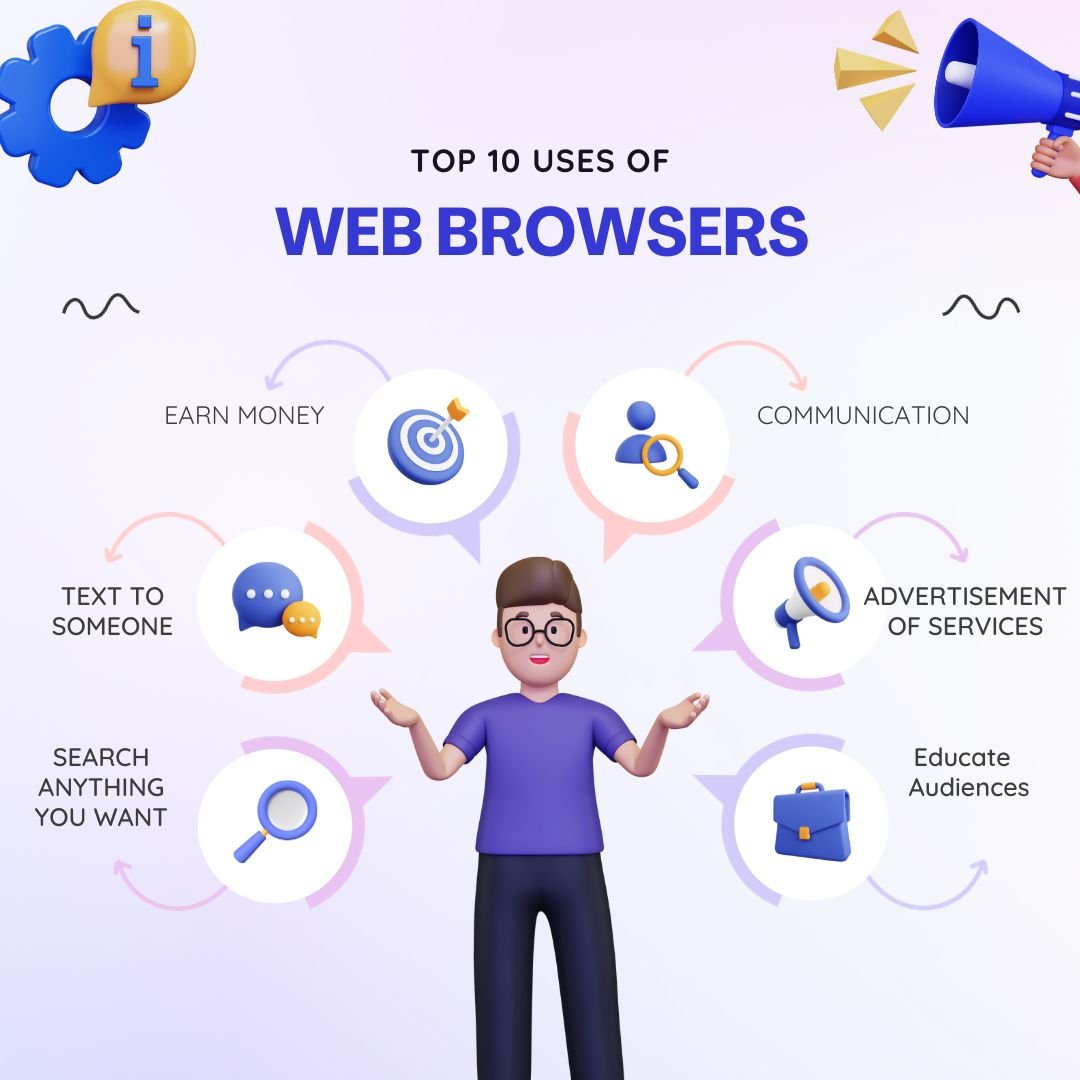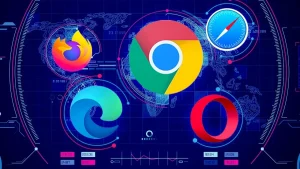Think of a web browser like a magic window to the internet. It’s a special program on your computer that helps you look at websites.
When you want to check out a website, like watching videos or shopping online, you open your web browser. It’s like a tool that helps you explore the internet.
But web browsers aren’t just for looking at stuff. They can also help build websites, keep your computer safe, and even grab information from the internet.
One more thing, web browsers can be like your secret friend for privacy. They can block annoying ads and stop websites from following you around.
So, as we learn about web browsers, you’ll see how they make the internet easy, keep you safe, and do some pretty cool things. It’s like having a special window to the online world!
If you want to create a list of 10 uses of web browsers
1.Using Bookmarks in Web Browsers
Think of bookmarks like your online shortcuts. When you find a webpage you really like or want to visit again, you can save it as a bookmark. It’s like making a quick note to yourself: “Come back here later!”
You can keep your bookmarks organized, sort of like arranging your favorite things into folders. This makes it easy to find what you’re looking for. To get to your bookmarks, just look for a star or a special icon in your browser.
Here’s something neat: some browsers can make your bookmarks available on both your computer and your phone, so you can access them from anywhere. And if your interests change or a link doesn’t work anymore, you can change or remove your bookmarks.
In a nutshell, bookmarks are your handy helpers on the internet. They save you time, keep your favorite pages handy, and make your online life simpler.
2.Forwarding to the next web page
The “next” button in a web browser helps you move to the next web page you want to see. Your browser uses special storage (called cache) to save the web pages you’ve visited before, so it can quickly show them to you when you hit the “next” button. This makes browsing faster because it doesn’t have to download everything again. So, with just a click, you can easily go from one web page to the next.
3.Backward to the next web page
When you want to go back to a webpage you’ve visited before, your web browser, like Google Chrome, makes it faster by keeping a copy of those pages. It’s like a quick-access memory. So, when you hit the “back” button, the browser doesn’t need to download everything again. It grabs the page from its memory, and you can easily go back to where you were before with just a click.
4.Tabbed browsing
Tabbed browsing is a cool feature in web browsers like Firefox, Google Chrome, and Opera. It lets you open many websites in different tabs within one window. This means you can have lots of web pages open at the same time without cluttering your screen. Google Chrome even has pinned tabs, which helps you group similar tabs together, like your email and social media. Tabbed browsing makes it easy to switch between websites and keeps things neat and tidy on your computer. It’s a handy way to browse the web.
5.Recording the web browsing history
Web browsers keep track of the websites you visit, creating a history list. This list is like a memory of where you’ve been online. It helps you find and go back to websites you’ve visited before. So, if you want to find a web page you like or need to revisit something, your browser’s history is like a helpful map to guide you, making it easier to use the internet.
6.**Scraping the web page content**
To scrape web page content, you can use handy tools like Puppeteer or Selenium. These tools automate web browsing, which means they can click buttons, go to websites, and get the info you need. Puppeteer is easy to use and is based on Google’s Chrome browser. It’s great for web scraping. Selenium is another useful tool that works with different web browsers, so it’s versatile. With these tools, you can quickly and easily collect data from web pages for various purposes like analyzing data or gathering content.
7.Taking the HTML Source Code
Getting the HTML source code of web pages is pretty handy. On Windows, you can do it easily by pressing “ctrl + u” while using a web browser. This is super useful for a few things. First, it’s great for web scraping, where you want to collect specific data from a webpage. It’s also helpful for checking the size and structure of a webpage’s building blocks, which is called the DOM. And guess what? You can do this for the entire website, not just one page, to analyze and make improvements. So, if you’re a developer, analyst, or just curious, peeking at the HTML source code can be quite helpful.
8.Controlling the Web Server IP Address
Being in charge of a web server’s IP address is essential for managing things online. You can find this address in the response headers, and it’s useful for a few reasons. First, it helps with security by allowing you to check for any weak points in your system. Second, it’s handy for load testing, which means seeing how well your website or app works when lots of people use it. When you can control the server’s IP address, you can make adjustments to ensure that everything runs smoothly and securely on the internet. So, it’s a powerful tool for businesses to keep their online services working well and safe for users.
9.Controlling the web Server Security
Making sure a web server is safe is really important. You can use a web browser to check if it’s secure. If it doesn’t have the right security settings, it could be risky for people using the internet. These settings help the browser protect users. Also, it’s a good idea to see how many people the server can handle at once. You can do this with web browser tools. It’s important to control the server’s security by setting up these protections and making sure it can handle lots of users without any problems. This way, everyone stays safe and happy while using the internet.
10.Displaying the local files
Using a web browser to view local files is handy. You can do this by providing a file path. It means you can open CSV, PDF, or PPTX files on your computer without needing the internet. This makes it super convenient to access and work with your files, like spreadsheets, documents, or presentations, directly from your own device. It’s a simple way to manage and use your files more efficiently.





